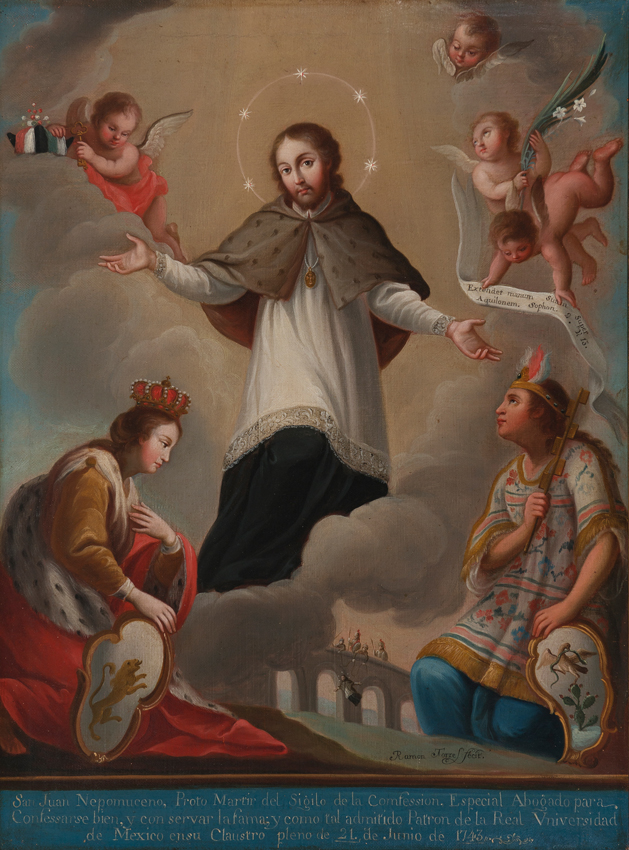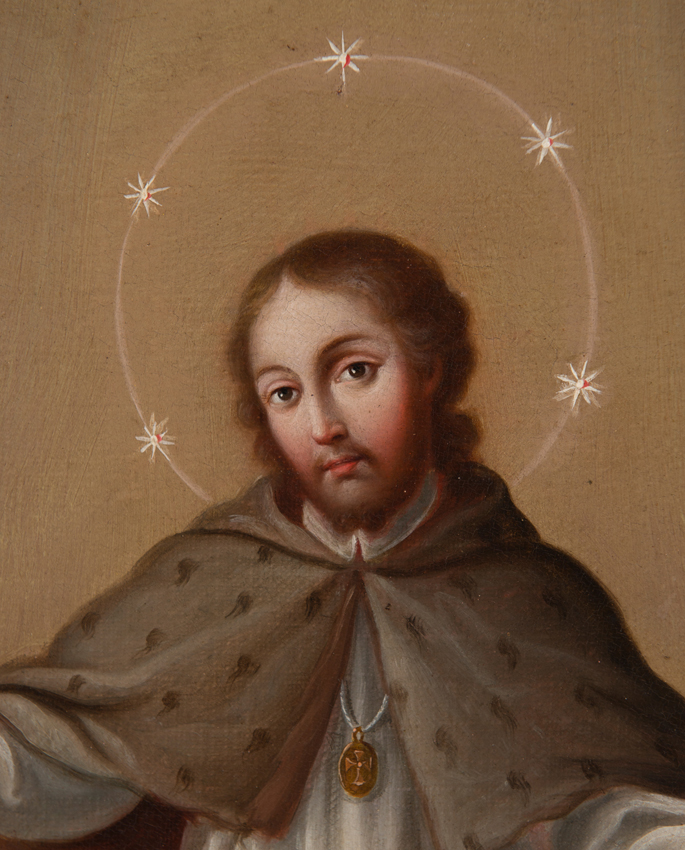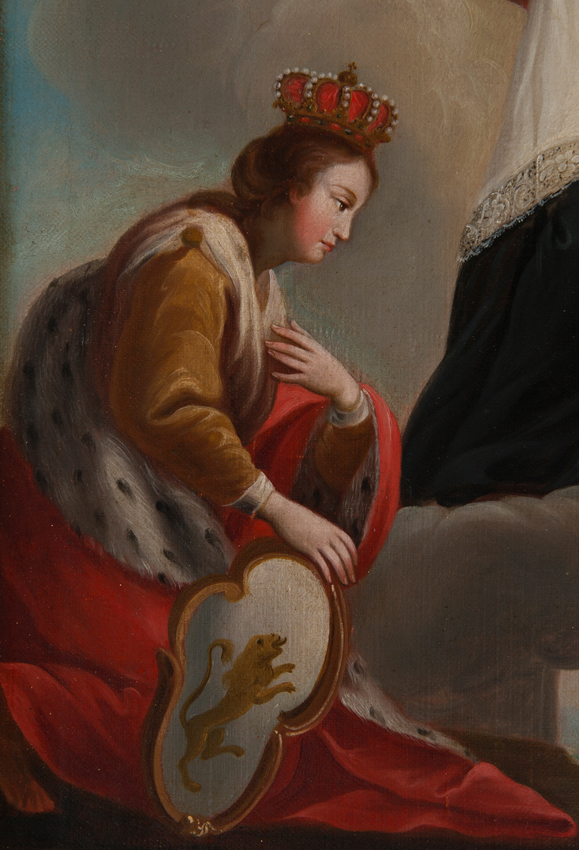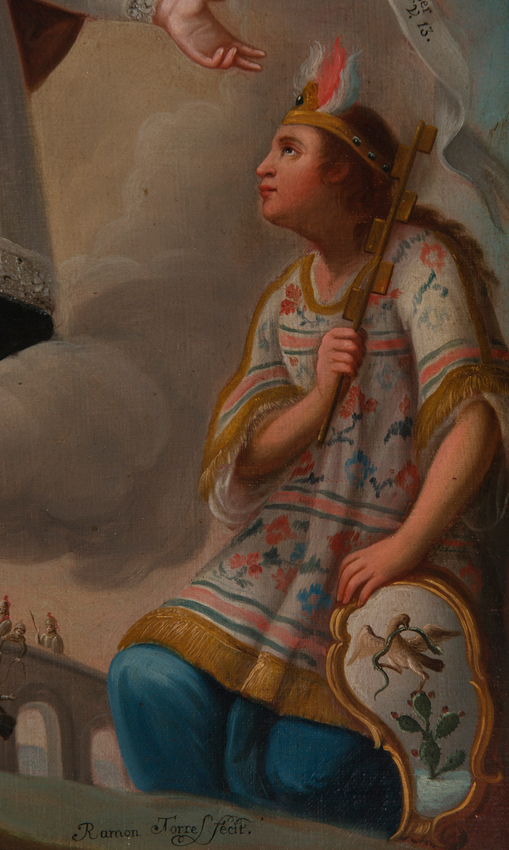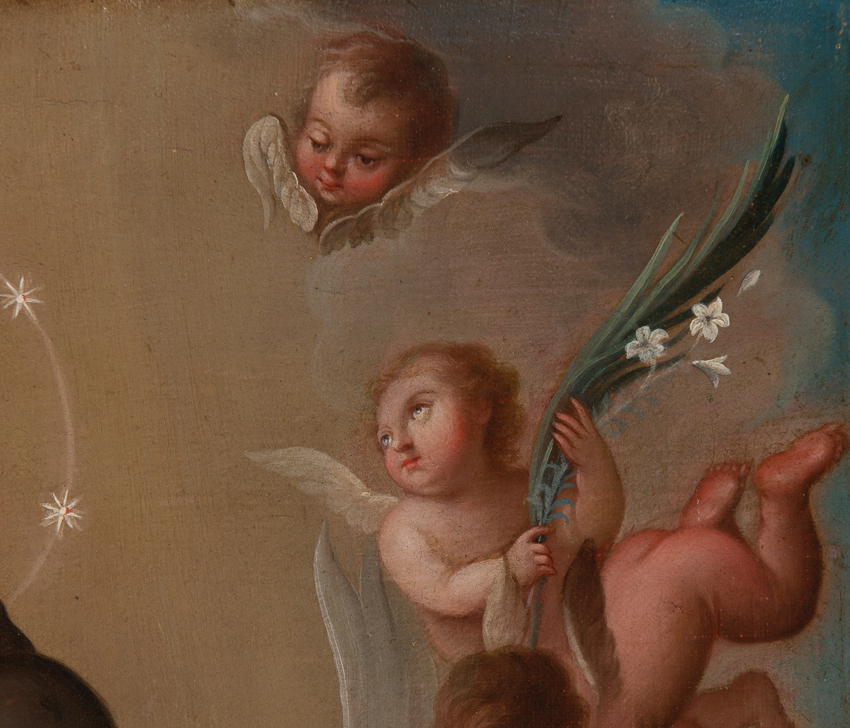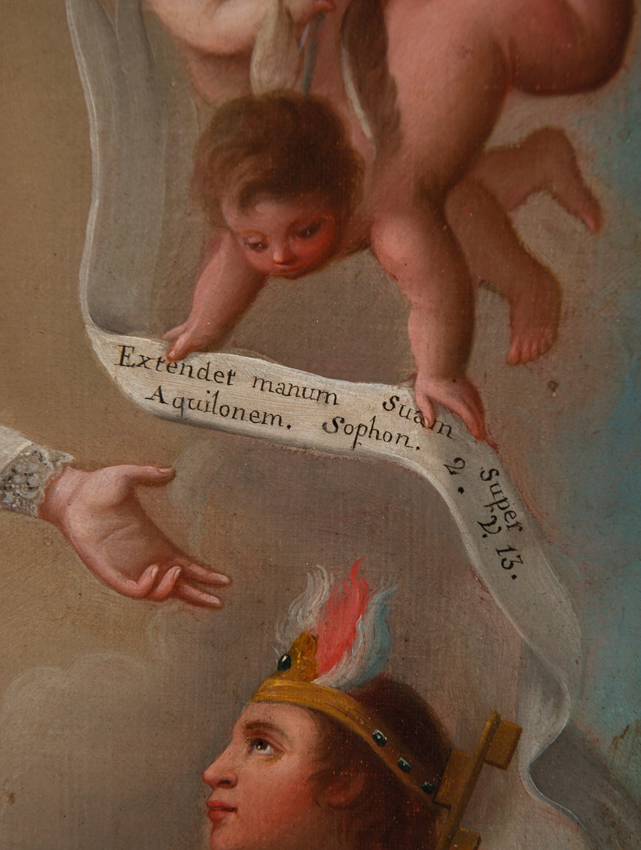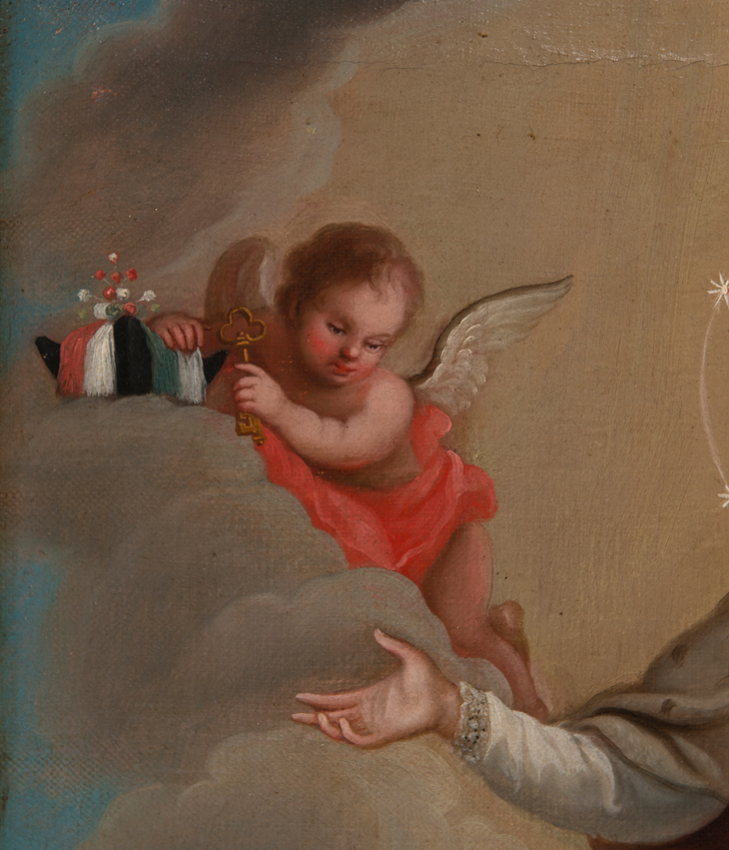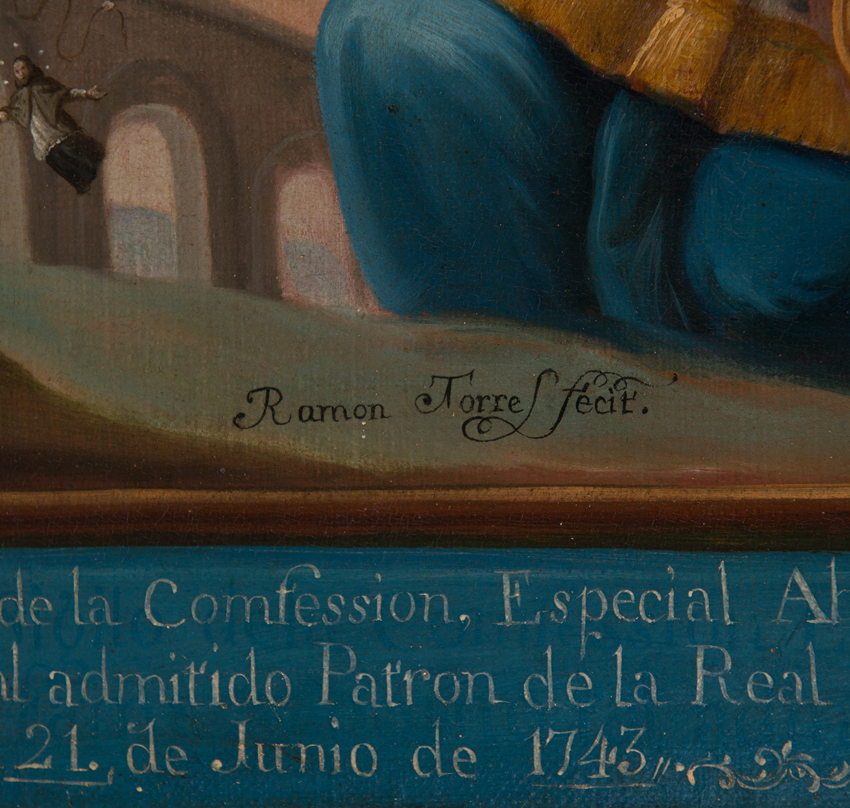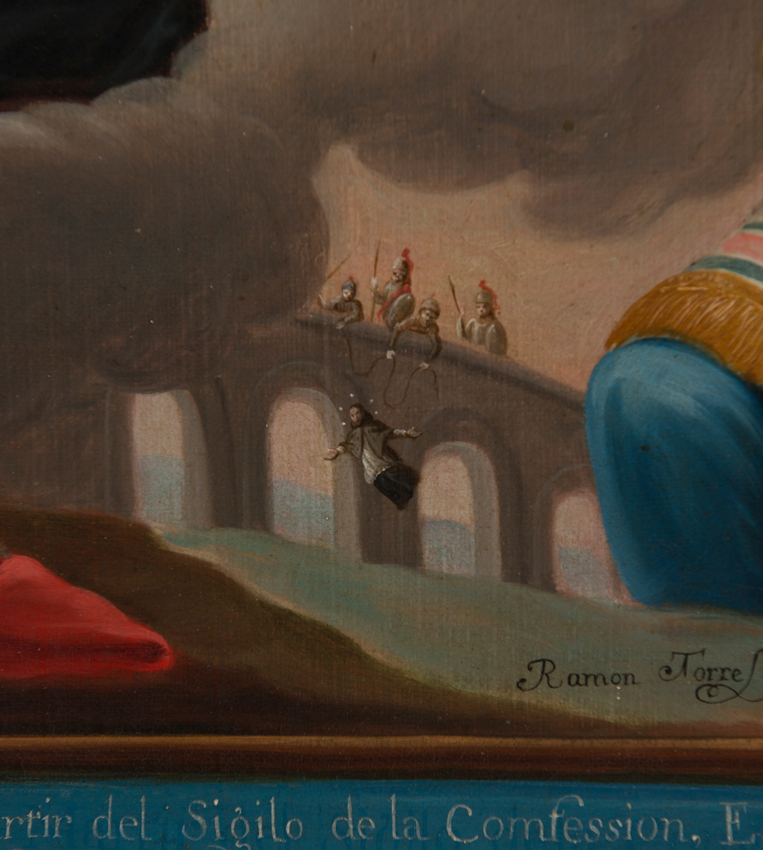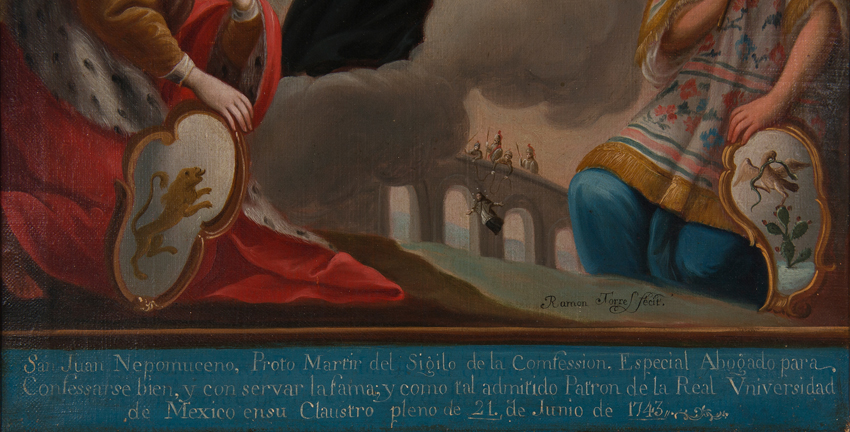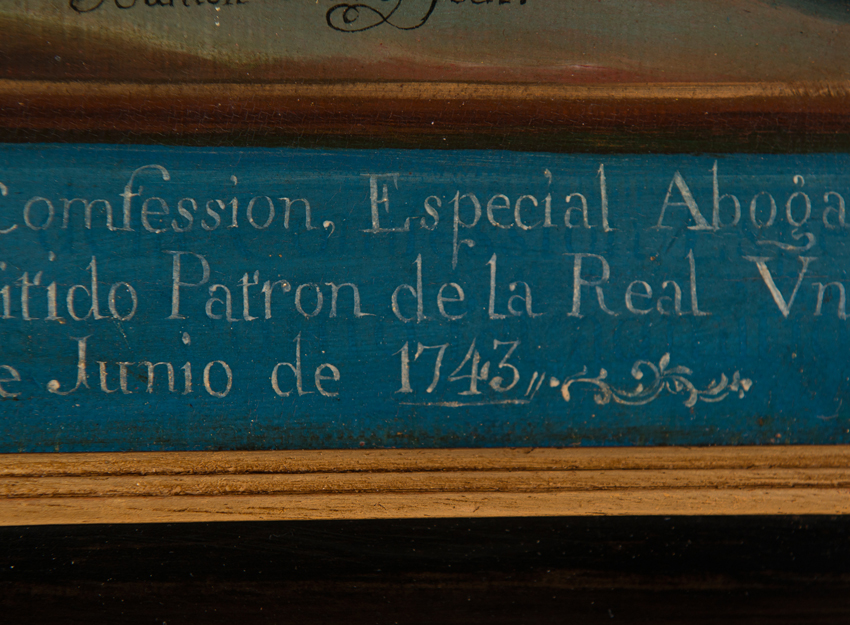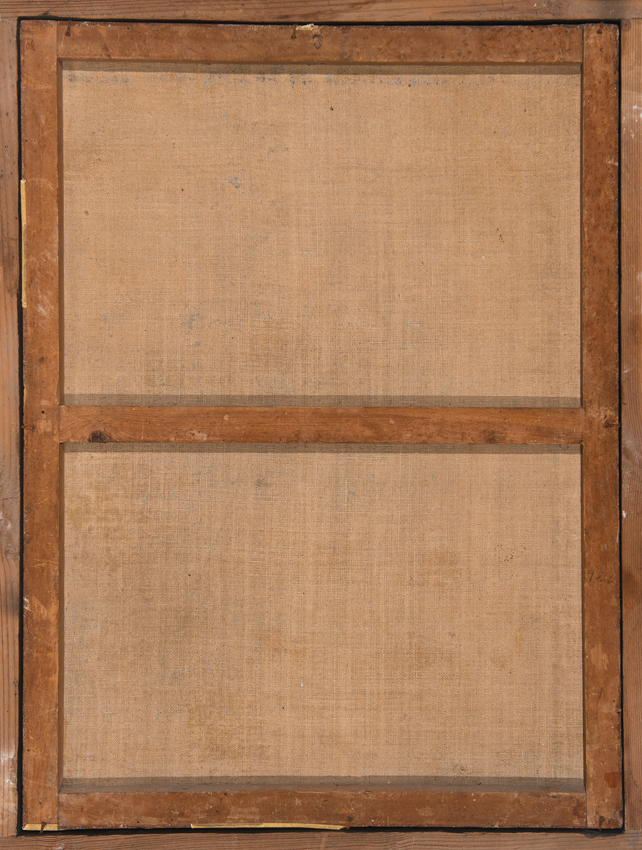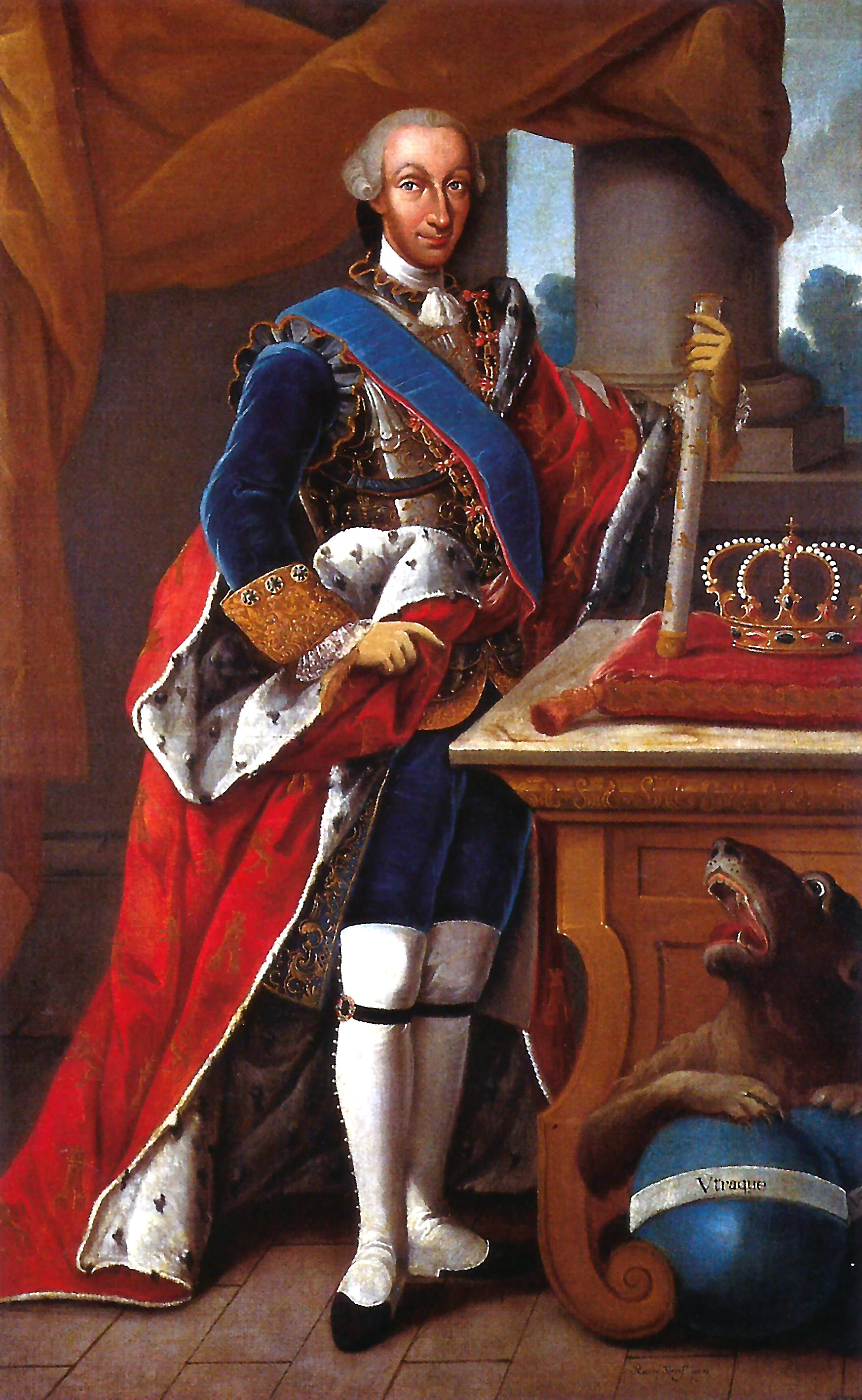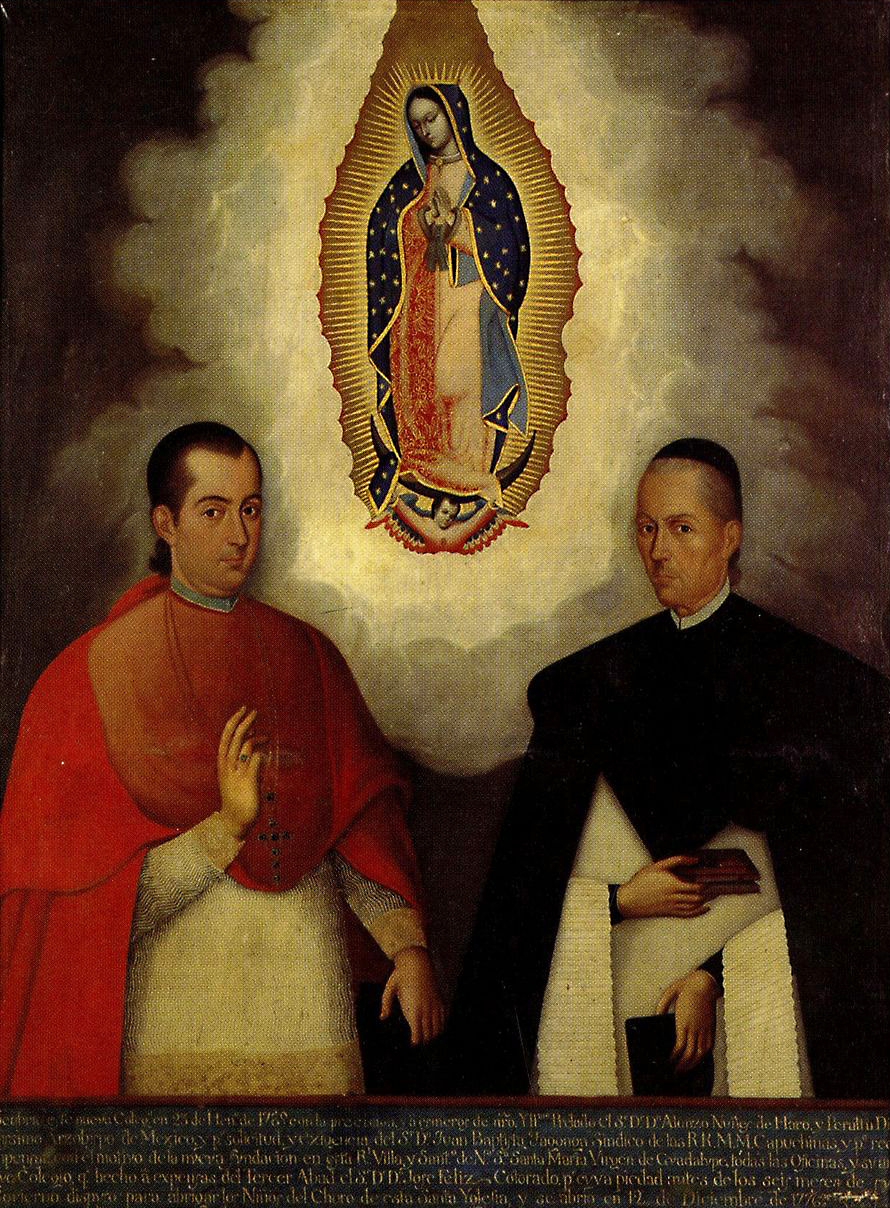40
Ramón Torres (Active in Mexico from 1740 - 1790)
Ramón Torres (Active in Mexico from 1740 - 1790)
‘Patronage of Saint John Nepomucene over the Spanish Kingdom and Empire and New Spain’.
Oil on canvas. Signed.
64 x 48 cm.
Exquisite canvas signed and dated in 1743, in the first half of the 18th century, by Ramón Torres (‘fecit’), one of the most renowned painters in New Spain, almost a copyist in the way he replicated the stroke and tenderness of Miguel Cabrera's brush, which is very similar in his work. He perfectly captures the Novo-Hispanic society´s particular taste of the time, a very refined taste for religious portrayals, full of mysticism and rapture.
In this splendid work we contemplate Saint John Nepomucene who, in ecstasy and already flying in Glory, surrounded by angels, exercises his protection over Spain (venerated in his Queen Maria Amalia of Saxony 1724-1759, wife of Charles III), and the native vicereine of New Spain and Mexico, both on their knees and in adoration of the martyred saint, to whom they ask for help.
Patron saint of Bohemia and martyr of fidelity to the sacrament of confession (in a low cartouche on a lapis lazuli blue background we read: SAN JUAN NEPOMUCENO, PROTO MÁRTIR DEL SIGILO DE LA CONFESSION. ESPECIAL ABOGADO PARA CONFESARSE BIEN, Y CONSERVAR LA FAMA: Y COMO TAL ADMIRADO PATRÓN DE LA REAL UNIVERSIDAD DE MÉXICO EN SU CLAUSTRO PLENO DE 21 DE JUNIO DE 1743. (SAINT JOHN NEPOMUCENE, PROTO-MARTYR OF THE SEAL OF CONFESSION. SPECIAL ADVOCATE FOR GOOD CONFESSION AND PRESERVING FAME: AND AS SUCH ADMIRED PATRON OF THE ROYAL UNIVERSITY OF MEXICO IN ITS PLENARY CLOISTER OF 21 JUNE 1743.)
Ramón Torres was a prominent painter amongst the ruling classes. On numerous occasions, he was commissioned to paint portraits of monarchs and notable figures, and the examples of his paintings that are preserved are testament to this.
Amongst these, we highlight those mentioned by José María de Francisco Olmos and David Ramírez Jiménez in an article in Hidalguía magazine: “We know that he painted several portraits of monarchs, at least of Charles II and Charles III, as well as some viceroys, and that of Antonia de Mendoza, [1st Viceroy of New Spain and 2nd of Peru (1490–1552), dated 1786, which is part of the collection of the Museum of the Americas in Madrid]". As the Museum explains, Viceroy Antonio de Mendoza governed New Spain between 1535 and 1550, as indicated by the explanatory caption at the bottom of the painting, accompanied by the heraldry of his lineage. The Museum's catalogue dates this piece to 1786 and states that it is a copy of an anonymous painting kept in the National History Museum in Mexico City, with certain modifications introduced by the artist—portraying the subject with a less stern appearance, suggesting that Torres was not merely a copyist. The explanatory cartouche bears the number I, which can lead us to believe that at some point Ramón Torres was commissioned to reproduce the full series of viceroys.
The painting we have here, given its dimensions and subject matter, was undoubtedly a commission destined for a private noble residence, as its size makes it unsuited to a church or religious congregation.
It is evident that it was produced during the reign of Charles III (1759–1788), since, as mentioned, the figure representing the Kingdom of Spain is none other than his wife, Queen Maria Amalia of Saxony (1724–1759).
Additionally, it is worth remembering that it was Ramón Torres who painted the great 1762 portrait of King Charles III now housed in the National Museum of History in Mexico. (https://arcav1.uniandes.edu.co/artworks/9788#)
Several viceroys served during the reign of Charles III, but in the context of this painting, there is one in particular who is of greatest relevance from both a chronological and historiographical perspective. This is Don Alonso Núñez de Haro y Peralta, a Spanish cleric who served as Archbishop of Mexico from 1772 until his death in 1787, and as Viceroy of New Spain during the final year of his life.
Considering that Ramón Torres painted him in the major artwork Portraits of the Archbishop of Mexico and Viceroy Don Alonso Núñez de Haro y Peralta and of Abbot José Félix Colorado under the Protection of the Virgin of Guadalupe, an oil painting dated circa 1776, which is kept in the Museum of the Basilica of Guadalupe, it is our hypothesis that the painting we present may have been commissioned by Archbishop Núñez de Haro to Ramón Torres, as a tribute to his king and to the New World over which he governed as Viceroy.
Returning to the life of Saint John of Nepomucene, he was canonised by Benedict XIII on 19 March 1729. He was martyred at the request and order of Wenceslas IV, King of Bohemia, for having refused to reveal the Queen's confession. The process of canonisation was carried out quickly, above all at the request of the Society of Jesus, who, in search of a patron saint, made this devotion their own due to the series of attacks and persecutions they were undergoing. It was Pope Clement XIII who approved the patronage to alleviate the plight of the Jesuits and this saint would be invoked to protect the ‘good name’ of the Society. Another important reason that popularised the worship of this saint was the fact that he was considered a martyr for the secrecy of confession.
A tender and devotional image, possibly commissioned by the Royal University of Mexico, which would have hung in the professors' room or cloister.
The angels of Glory hold his bonnet, the palm of martyrdom and lilies of his purity, and a phylactery that reads: EXTENDET MANUM SUAM SUPER AQUILONEM. Sophon. 2, v. 13) a verse from the prophet Zephaniah, ‘He will stretch out his hand over (against) the north’, which indicates that the God of Israel will destroy, annihilate and exterminate the people of Assyria (in general ‘all the enemies of Spain and New Spain’).
Bibliography:
- Olmos, José María de Francisco y Ramírez Jiménez, David (2017). “La heráldica y la falerística en la identificación de las obras de arte: el supuesto retrato de Matías de Gálvez del museo de América de Madrid”. Revista Hidalguía, nº 374 (enero-abril 2017), pp.113-146.
- Katzew, Ilona. (2004). "La pintura de castas: Representaciones raciales en el México del siglo XVIII". Turner Publicaciones S.L.
Ramón Torres (Active in Mexico from 1740 - 1790)
‘Patronage of Saint John Nepomucene over the Spanish Kingdom and Empire and New Spain’.
Oil on canvas. Signed.
64 x 48 cm.
Exquisite canvas signed and dated in 1743, in the first half of the 18th century, by Ramón Torres (‘fecit’), one of the most renowned painters in New Spain, almost a copyist in the way he replicated the stroke and tenderness of Miguel Cabrera's brush, which is very similar in his work. He perfectly captures the Novo-Hispanic society´s particular taste of the time, a very refined taste for religious portrayals, full of mysticism and rapture.
In this splendid work we contemplate Saint John Nepomucene who, in ecstasy and already flying in Glory, surrounded by angels, exercises his protection over Spain (venerated in his Queen Maria Amalia of Saxony 1724-1759, wife of Charles III), and the native vicereine of New Spain and Mexico, both on their knees and in adoration of the martyred saint, to whom they ask for help.
Patron saint of Bohemia and martyr of fidelity to the sacrament of confession (in a low cartouche on a lapis lazuli blue background we read: SAN JUAN NEPOMUCENO, PROTO MÁRTIR DEL SIGILO DE LA CONFESSION. ESPECIAL ABOGADO PARA CONFESARSE BIEN, Y CONSERVAR LA FAMA: Y COMO TAL ADMIRADO PATRÓN DE LA REAL UNIVERSIDAD DE MÉXICO EN SU CLAUSTRO PLENO DE 21 DE JUNIO DE 1743. (SAINT JOHN NEPOMUCENE, PROTO-MARTYR OF THE SEAL OF CONFESSION. SPECIAL ADVOCATE FOR GOOD CONFESSION AND PRESERVING FAME: AND AS SUCH ADMIRED PATRON OF THE ROYAL UNIVERSITY OF MEXICO IN ITS PLENARY CLOISTER OF 21 JUNE 1743.)
Ramón Torres was a prominent painter amongst the ruling classes. On numerous occasions, he was commissioned to paint portraits of monarchs and notable figures, and the examples of his paintings that are preserved are testament to this.
Amongst these, we highlight those mentioned by José María de Francisco Olmos and David Ramírez Jiménez in an article in Hidalguía magazine: “We know that he painted several portraits of monarchs, at least of Charles II and Charles III, as well as some viceroys, and that of Antonia de Mendoza, [1st Viceroy of New Spain and 2nd of Peru (1490–1552), dated 1786, which is part of the collection of the Museum of the Americas in Madrid]". As the Museum explains, Viceroy Antonio de Mendoza governed New Spain between 1535 and 1550, as indicated by the explanatory caption at the bottom of the painting, accompanied by the heraldry of his lineage. The Museum's catalogue dates this piece to 1786 and states that it is a copy of an anonymous painting kept in the National History Museum in Mexico City, with certain modifications introduced by the artist—portraying the subject with a less stern appearance, suggesting that Torres was not merely a copyist. The explanatory cartouche bears the number I, which can lead us to believe that at some point Ramón Torres was commissioned to reproduce the full series of viceroys.
The painting we have here, given its dimensions and subject matter, was undoubtedly a commission destined for a private noble residence, as its size makes it unsuited to a church or religious congregation.
It is evident that it was produced during the reign of Charles III (1759–1788), since, as mentioned, the figure representing the Kingdom of Spain is none other than his wife, Queen Maria Amalia of Saxony (1724–1759).
Additionally, it is worth remembering that it was Ramón Torres who painted the great 1762 portrait of King Charles III now housed in the National Museum of History in Mexico. (https://arcav1.uniandes.edu.co/artworks/9788#)
Several viceroys served during the reign of Charles III, but in the context of this painting, there is one in particular who is of greatest relevance from both a chronological and historiographical perspective. This is Don Alonso Núñez de Haro y Peralta, a Spanish cleric who served as Archbishop of Mexico from 1772 until his death in 1787, and as Viceroy of New Spain during the final year of his life.
Considering that Ramón Torres painted him in the major artwork Portraits of the Archbishop of Mexico and Viceroy Don Alonso Núñez de Haro y Peralta and of Abbot José Félix Colorado under the Protection of the Virgin of Guadalupe, an oil painting dated circa 1776, which is kept in the Museum of the Basilica of Guadalupe, it is our hypothesis that the painting we present may have been commissioned by Archbishop Núñez de Haro to Ramón Torres, as a tribute to his king and to the New World over which he governed as Viceroy.
Returning to the life of Saint John of Nepomucene, he was canonised by Benedict XIII on 19 March 1729. He was martyred at the request and order of Wenceslas IV, King of Bohemia, for having refused to reveal the Queen's confession. The process of canonisation was carried out quickly, above all at the request of the Society of Jesus, who, in search of a patron saint, made this devotion their own due to the series of attacks and persecutions they were undergoing. It was Pope Clement XIII who approved the patronage to alleviate the plight of the Jesuits and this saint would be invoked to protect the ‘good name’ of the Society. Another important reason that popularised the worship of this saint was the fact that he was considered a martyr for the secrecy of confession.
A tender and devotional image, possibly commissioned by the Royal University of Mexico, which would have hung in the professors' room or cloister.
The angels of Glory hold his bonnet, the palm of martyrdom and lilies of his purity, and a phylactery that reads: EXTENDET MANUM SUAM SUPER AQUILONEM. Sophon. 2, v. 13) a verse from the prophet Zephaniah, ‘He will stretch out his hand over (against) the north’, which indicates that the God of Israel will destroy, annihilate and exterminate the people of Assyria (in general ‘all the enemies of Spain and New Spain’).
Bibliography:
- Olmos, José María de Francisco y Ramírez Jiménez, David (2017). “La heráldica y la falerística en la identificación de las obras de arte: el supuesto retrato de Matías de Gálvez del museo de América de Madrid”. Revista Hidalguía, nº 374 (enero-abril 2017), pp.113-146.
- Katzew, Ilona. (2004). "La pintura de castas: Representaciones raciales en el México del siglo XVIII". Turner Publicaciones S.L.
Millésime 25 · 20th anniversary of La Suite Subastas
Sale Date(s)
Venue Address
General delivery information available from the auctioneer
The purchase price includes the delivery of the lots in the venue of the auction. Transporting to other destinations is at the own risk of the client. The customer must contact "LST", to give the corresponding instructions for such transporting. "LST" is not responsible for the packaging or any accident incurred during transportation.
Important Information
It is important please, that you read our conditions of sale before the auction. If you need us to send them to you by mail, just ask for them.
We would like to remind you that in compliance with Spanish historical heritage laws, lots over 100 years old will need a license, which we will take care of processing for you. This process can take up to a month, as the Ministry of Culture holds only one meeting per month.
The Spanish administration does not charge anything for clients within the European Community, but for non-European Community buyers, the Spanish administration does apply fees. Please contact us for more details on the cost of these fees.
Terms & Conditions
CONDITIONS OF THE AUCTION:
I. REGISTRATION. To bid in the room customers must register at the beginning, filling out a form and picking a number that will identify them during the auction. Customers may be required to register in bank references or other guarantee system and if they do not prove the solvency "LST" will not accept bids and award the auction.
II. WRITTEN BIDS. "LST" will accept written bids, which will be formalized in the form provided by the room until the day before the auction. In such auctions, the room will bid in name of the client until the maximum stated in the offer and always at the lowest possible price. If there are two or more bids for the same amount, the one placed first will have the priority. Written bids received in advance, will have priority on the day of the auction.
III. TELEPHONE BIDS. "LST" will allow telephone bids, if interested people contact "LST" days before the auction providing personal data, ID card and the phone number which will be used by the staff of "LST" to call at the time of the auction. The buyer, within all the legal rights is making an offer for the asking price, when applies for telephone bid. "LST" will not take responsibility for any technical defects beyond its control, which may prevent to contact successfully the bidder during the auction.
IV. AUCTIONEER. The auction will be conducted by an auctioneer, director of the auction will be judge and arbitrator of it with full authority in its development, will award the lots to the highest bidder and is able to settle any controversy concerning lots sale, reject bids, divide lots or group them and remover objects from the room. Will be able to, if it is deemed suitable, not accept bids on the auction. His decision will be unappealable.
V. SALE OF LOTS. The lots are awarded to the highest bidder. Once the auctioneer blows the hammer, the buyer becomes responsible of the lot purchased, exempting "LST" of liability to for any damage and / or accidents that may occur. No refunds of lots.
VI. STARTING PRICE. The amount shown in the catalogue as the starting price for each lot will be, as a rule, the minimum selling price, except for exceptional cases where a reservation may be agreed upon with the seller or it set discretionary by the room.
VII. SCALE OF BIDS. The bids are set according to the following scale:
From 50.-€ to 200.-€…………………………………………..at 10.-€
From 200.-€ to 500.-€…………………………………… …25 in 25.-€
From 500.-€ to 1.000.-€………………………………..…..….50 in 50.-€
From 1.000.-€ to 2.000.-€………………………………..…100 in 100.-€
From 2.000.-€ to 5.000.-€……………………………….….250 in 250.-€
From 5.000.-€ to 10.000.-€…………………………………500 in 500.-€
From 10.000.-€ to 20.000.-€……………………………1.000 in 1.000.-€
From 20.000.-€ to 50.000.-€……………………………2.500 in 2.500.-€
From 50.000.-€ to 100.000.-€…………………………..5.000 in 5.000.-€
From 100.000.-€ to 100.000.-€………………………10.000 in 10.000.-€
From 200.000.-€ to 200.000.-€………………………25.000 in 25.000.-€
From 500.000.-€ to 500.000.-€………………………50.000 in 50.000.-€
VIII. RIGHT OF ADMISION. "LST" reserves the right to admission to the auction room and to reject, at its judgment, any purchase order, from clients whose solvency is not duly proved as well as not to sale auctions.
IX. SALE PRICES. The successful bidder of one or more lots must pay "LST" the final sale price achieves at auction, plus the 24,5 % plus 21% VAT on the commission, at total 29,64 % on Hammer Price.
X. CATALOG DATA. The catalogue data are obtained in order to careful research and advice, however, any responsibility is afforded about its accuracy. The lots will be auctioned in the state in which they are, not accepting any claims in restorations, breakage, damage, imperfections and, even description or numbering mistakes in the catalogue, in case of it, being the burden of the buyers to make sure before the auction that the description matches with their personal opinion about respective lot. The exhibition of the lots is intended to allow a perfect review and study of them.
XI. PAYMENT AND REMOVAL OF LOTS. Payment and removal of the lots will be held no later than five days following the auction. After this period expire without having the buyer removed the lot or lots purchases, it will accrue an expense of custody of 6 euros per day on each lot.
15 days after the auction without having the buyer paid and removes the sold lots, "LST" will inform the seller and there will begin judicial proceeding in order to obtain payment. The delay in payment by the purchaser of his/her sold lots will carry an interest increase at a rate of 1,5% per month.
XII. DELIVERY OF LOTS. The purchase price includes the delivery of the lots in the venue of the auction. Transporting to other destinations is at the own risk of the client. The customer must contact "LST", to give the corresponding instructions for such transporting. "LST" is not responsible for the packaging or any accident incurred during transportation.
XIII. RIGHT OF FIRT REFUSAL AND REPURCHASE. "LST" in order to article 38 of "Ley 16/1985 de 25 Junio del Patrimonio Histórico Español" (BOE. 155 June 29, 1985), will notify in advance to the Ministry of Culture, the content of their catalogues. Concerning the lots subject to the legislation referred to in the preceding paragraph, the Administration may exercise the rights of first refusal and repurchase according to the law. "LST" will watch over the protection of Artistic, Historical and Bibliographical Heritage of Spain. For customers out of European Community, a tax for export is required by the Administration.
XIV. EXPORT LICENSE. In compliance with Spanish historical heritage laws, lots over 100 years old need a export license, which we will take care of processing for you. The Spanish administration does not charge anything for clients within the European Community, but for non-European Community buyers, the Spanish administration does apply fees. Please contact us for more details on the cost of these fees.
XV. VALUE ADDED TAX (I.V.A). This tax will be accrued on commissions of "LST" for buyers, using the rates prevailing on the date of the auction.
XVI. DATA PROTECTION. In order to the "Ley 15/1999 de 13 de Diciembre, de Protección de Datos de Carácter Personal", the client authorize "LST", the inclusion of their data in a customer file, and for the promotion by "LST" of the objects at all times the rights of access, rectification or deletion of personal data by sending the appropriate request to the following address: LA SUITE SUBASTAS, C/ Conde Salvatierra, 8, 08006. Barcelona.
XVII. EXPRESS LEGAL JURISDICTION. These Conditions are governed by and interpreted in accordance with the rules of Spanish law. The mere act of participating in the auction as seller, buyer or bidder, implies acceptance of these Terms and Conditions.
Sales operations are understood to be held at the registered office of "LST", C/ Conde de Salvatierra, 8, 08006. Any dispute shall be taken to the competent courts of Barcelona, expressly waiving any other jurisdiction, in accordance with Article 55 of the "Ley de Enjuiciamiento Civil".
































